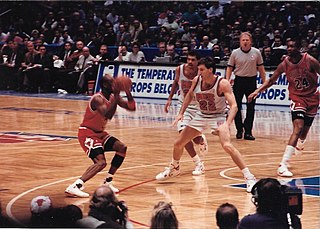
Basketball is a team sport in which two teams, most commonly of five players each, opposing one another on a rectangular court, compete with the primary objective of shooting a basketball through the defender's hoop, while preventing the opposing team from shooting through their own hoop. A field goal is worth two points, unless made from behind the three-point line, when it is worth three. After a foul, timed play stops and the player fouled or designated to shoot a technical foul is given one, two or three one-point free throws. The team with the most points at the end of the game wins, but if regulation play expires with the score tied, an additional period of play (overtime) is mandated.

Polo is a ball game that is played on horseback, a traditional field sport and one of the world's oldest known team sports. The game is played by two opposing teams with the objective of scoring using a long-handled wooden mallet to hit a small hard ball through the opposing team's goal. Each team has four mounted riders, and the game usually lasts one to two hours, divided into periods called chukkas or chukkers.

Racquetball is a racquet sport and a team sport played with a hollow rubber ball on an indoor or outdoor court. Joseph Sobek invented the modern sport of racquetball in 1950, adding a stringed racquet to paddleball in order to increase velocity and control. Unlike most racquet sports, such as tennis and badminton, there is no net to hit the ball over, and, unlike squash, no tin to hit the ball above. Also, the court's walls, floor, and ceiling are legal playing surfaces, with the exception of court-specific designated hinders being out-of-bounds. Racquetball is played between various players on a team who try to bounce the ball with the racquet onto the ground so it hits the wall, so that an opposing team’s player cannot bounce it back to the wall.
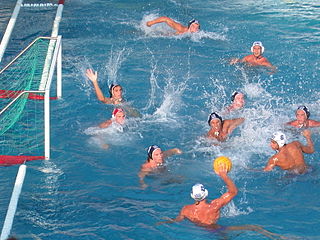
Water polo is a competitive team sport played in water between two teams of seven players each. The game consists of four quarters in which the teams attempt to score goals by throwing the ball into the opposing team's goal. The team with the most goals at the end of the game wins the match. Each team is made up of six field players and one goalkeeper. Excluding the goalkeeper, players participate in both offensive and defensive roles. It is typically played in an all-deep pool where players cannot touch the bottom.

Softball is a sport similar to baseball, and it is played with a larger ball on a smaller field and with only underhand pitches permitted. Softball is played competitively at club levels, the college level, and the professional level. The game was first created in 1887 in Chicago by George Hancock.

An arena is a large enclosed platform, often circular or oval-shaped, designed to showcase theatre, musical performances, or sporting events. It is composed of a large open space surrounded on most or all sides by tiered seating for spectators, and may be covered by a roof. The key feature of an arena is that the event space is the lowest point, allowing maximum visibility. Arenas are usually designed to accommodate a multitude of spectators.

In sport, a goal may refer to either an instance of scoring, or to the physical structure or area where an attacking team must send the ball or puck in order to score points. The structure of a goal varies from sport to sport, and one is placed at or near each end of the playing field for each team to defend. For many sports, each goal structure usually consists of two vertical posts, called goal posts, supporting a horizontal crossbar. A goal line marked on the playing surface between the goal posts demarcates the goal area. Thus, the objective is to send the ball or puck between the goal posts, under or over the crossbar, and across the goal line. Other sports may have other types of structures or areas where the ball or puck must pass through, such as the basketball hoop. Sports which feature goal scoring are also commonly known as invasion games.
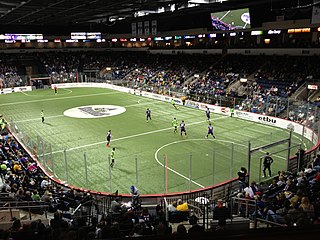
Indoor soccer or arena soccer is a five-a-side or six-a-side version of minifootball, derived from association football and adapted to be played in walled hardcourt indoor arena. Indoor soccer, as it is most often known in the United States and Canada, was originally developed in these two countries as a way to play soccer during the winter months, when snow would make outdoor play difficult. In those countries, gymnasiums are adapted for indoor soccer play. In other countries the game is played in either indoor or outdoor arenas surrounded by walls, and is referred to by different names.
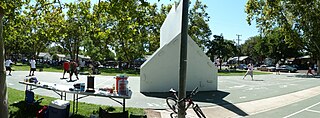
American handball, known as handball in the United States and sometimes referred to as wallball, is a sport in which players use their hands to hit a small, rubber ball against a wall such that their opponent(s) cannot do the same without the ball touching the ground twice or hitting out-of-bounds. The three versions are four-wall, three-wall and one-wall. Each version can be played either by two players (singles), three players (cutthroat) or four players (doubles), but in official tournaments, singles and doubles are the only versions played.
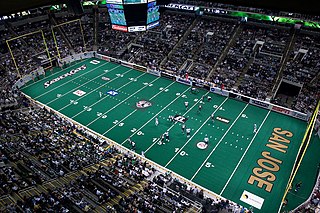
Arena football is a variety of eight-man indoor gridiron football. The game is played indoors on a smaller field than American or Canadian football, designed to fit in the same surface area as a standard North American ice hockey rink, resulting in a faster and higher-scoring game that can be played on the floors of indoor arenas. The sport was invented in 1981, and patented in 1987, by Jim Foster, a former executive of the National Football League and the United States Football League. The name is trademarked by Gridiron Enterprises and had a proprietary format until its patent expired in 2007.
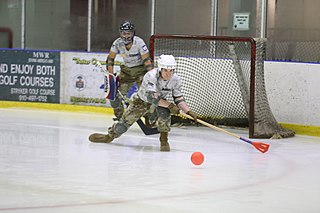
Broomball is a both a recreational and organized competitive winter team sport played on ice or snow and is played either indoors or outdoors, depending on climate and location. It is a ball sport and is most popularly played in Canada and the United States.

Polocrosse is a team sport that is a combination of polo and lacrosse. It is played outside, on a field, on horseback. Each rider uses a cane or fibreglass stick to which is attached a racquet head with a loose, thread net, in which the ball is carried. The ball is made of sponge rubber and is approximately four inches across. The objective is to score goals by throwing the ball between the opposing team's goal posts.
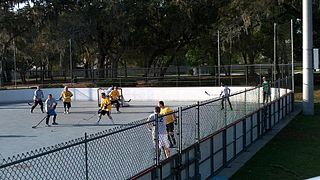
Street hockey is a collection of team sport variants played outdoors either on foot or with wheeled skates, using either a ball or puck designed for play on flat, dry surfaces. The object of every game is to score more goals than the opposing team by shooting the ball or puck into the opposing team's net. All games are derivatives of either the sport of ice hockey, floor hockey, bandy, and/or field hockey.

Fistball is a sport of European origin, primarily played in the German-speaking nations of Austria, Germany and Switzerland, as well as in Brazil. The objective of the game is similar to volleyball, in that teams try to hit a ball over a net, but the rules vary from volleyball in several major ways. The current men's fistball World Champions are Germany, winners of both the 2023 Men's World Championships and the fistball category at the 2022 World Games, while the current women's fistball World Champions are also Germany, after winning the 2021 Women's World Championships.

Padel, sometimes called padel tennis, is a racket sport of Mexican origin, typically played in doubles on an enclosed court slightly smaller than a doubles tennis court. Although padel shares the same scoring system as tennis, the rules, strokes, and technique are different. The balls used are similar but with a little less pressure. The main differences are that the court has walls and the balls can be played off them in a similar way as in the game of squash and that solid, stringless bats are used. The height of the ball being served must be at or below the waist level.

A pitch or a sports ground is an outdoor playing area for various sports. The term pitch is most commonly used in British English, while the comparable term in Australian, American and Canadian English is playing field or sports field.
Several sports related to volleyball have become popular. Indoor volleyball and beach volleyball are both events at the Olympics, and sitting volleyball is an event at the Paralympics. Other varieties are localized, or are played at an amateur or informal level.
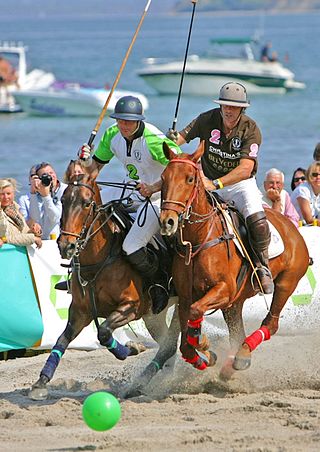
Beach polo is a team sport and close variant of arena polo.
Cowboy polo is a variation of polo played mostly in the western United States. Like regular polo, it is played in chukkas (periods) with two teams on horses who use mallets to hit a ball through a goal. It differs from traditional polo in that five riders make up a team instead of four, western saddles and equipment are used, and the playing field is usually a simple rodeo arena or other enclosed dirt area, indoors or out. Also, instead of the small ball used in traditional polo, the players use a large red rubber medicine ball and use mallets with long fiberglass shafts and hard rubber heads.
















